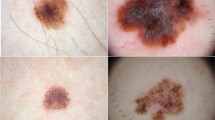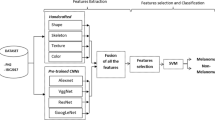Abstract
In this article, we are addressing the question of effective usage of the feature set extracted from deep learning models pre-trained on ImageNet. Exploring this option will offer very fast and attractive alternative to transfer learning strategies. The traditional task of skin lesion recognition consists of several stages, where the automated system is typically trained on preprocessed images with known diagnosis, which allows classification of new samples to predefined categories. For this task, we are proposing here an improved melanoma detection method based on the combination of linear discriminant analysis (LDA) and the features extracted from the deep learning approach. We are examining the usage of the LDA approach on activation of the fully-connected layer of deep learning in order to increase the classification accuracy and at the same time to reduce the feature space dimensionality. We tested our method on five different classifiers and evaluated results using various metrics. The presented comparison demonstrates the very high effectiveness of the suggested feature reduction, which leads not only to the significant lowering of employed features but also to the increasing performance of all tested classifiers in almost all measured characteristics.






















Similar content being viewed by others
References
Abbas Q, Celebi ME, García IF (2011) Hair removal methods: a comparative study for dermoscopy images. Biomed Signal Process Control 6(4):395–404
Argenziano G, Soyer HP, Chimenti S, Talamini R, Corona R, Sera F, Binder M, Cerroni L, De Rosa G, Ferrara G et al (2003) Dermoscopy of pigmented skin lesions: results of a consensus meeting via the internet. J Am Acad Dermatol 48(5):679–693
Athiwaratkun B, Kang K (2015) Feature representation in convolutional neural networks. arXiv:1507.02313
Ballerini L, Fisher RB, Aldridge B, Rees J (2013) A color and texture based hierarchical k-NN approach to the classification of non-melanoma skin lesions. In: Color medical image analysis. Springer, pp 63–86
Barata C, Ruela M, Francisco M, Mendonça T, Marques JS (2014) Two systems for the detection of melanomas in dermoscopy images using texture and color features. IEEE Syst J 8(3):965–979
Bernstein A, Kuleshov A (2014) Dimensionality reduction in statistical learning. In: 13Th international conference on machine learning and applications (ICMLA). IEEE, pp 330–335
Beuren AT, Pinheiro RJG, Facon J (2012) Color approach of melanoma lesion segmentation. In: Systems, signals and image processing. IEEE, pp 284–287
Chatfield K, Simonyan K, Vedaldi A, Zisserman A (2014) Return of the devil in the details: delving deep into convolutional nets. arXiv:1405.3531
Cireşan DC, Giusti A, Gambardella LM, Schmidhuber J (2013) Mitosis detection in breast cancer histology images with deep neural networks. In: International conference on medical image computing and computer-assisted intervention. Springer, pp 411–418
Codella N, Cai J, Abedini M, Garnavi R, Halpern A, Smith JR (2015) Deep learning, sparse coding, and SVM for melanoma recognition in dermoscopy images. In: International workshop on machine learning in medical imaging. Springer, pp 118–126
Codella N, Nguyen QB, Pankanti S, Gutman D, Helba B, Halpern A, Smith J (2017) Deep learning ensembles for melanoma recognition in dermoscopy images. IBM J Res Dev 61(4):5–1
Esteva A, Kuprel B, Novoa RA, Ko J, Swetter SM, Blau HM, Thrun S (2017) Dermatologist-level classification of skin cancer with deep neural networks. Nature 542(7639):115–118
Fisher RA (1936) The use of multiple measurements in taxonomic problems. Ann Hum Genet 7(2):179–188
Geisler J, Bachmann IM, Nyakas M, Helsing P, Fjøsne HE, Maehle LO, Aamdal S, Eide NA, Svendsen HL, Straume O (2013) Malignant melanoma–diagnosis, treatment and follow-up in Norway. Tidsskrift for den Norske laegeforening: tidsskrift for praktisk medicin, ny raekke 133(20):2154–2159
Gilmore S, Hofmann-Wellenhof R, Soyer HP (2010) A support vector machine for decision support in melanoma recognition. Exp Dermatol 19(9):830–835
Giraldi GA, Rodrigues PS, Kitani EC, Thomaz CE (2008) Deep learning for health informatics. RITA 15(1):137–169
Glowacz A, Glowacz Z (2016) Recognition of images of finger skin with application of histogram, image filtration and k-NN classifier. Bioprocess Biosyst Eng 36(1):95–101
Gutman D, Codella NCF, Celebi E, Helba B, Marchetti M, Mishra N, Halpern A (2016) Skin lesion analysis toward melanoma detection: a challenge at the international symposium on biomedical imaging (ISBI) 2016, hosted by the international skin imaging collaboration (ISIC). CoRR arXiv:1605.01397
Haenssle H, Fink C, Schneiderbauer R, Toberer F, Buhl T, Blum A, Kalloo A, Hassen A, Thomas L, Enk A et al (2018) Man against machine: diagnostic performance of a deep learning convolutional neural network for dermoscopic melanoma recognition in comparison to 58 dermatologists. Ann Oncol 29(8):1836–1842
Jolliffe I (2011) Principal component analysis. In: International encyclopedia of statistical science. Springer, pp 1094–1096
Kawahara J, BenTaieb A, Hamarneh G (2016) Deep features to classify skin lesions. In: 13Th international symposium on biomedical imaging (ISBI). IEEE, pp 1397–1400
Keogh E, Mueen A (2011) Curse of dimensionality. In: Encyclopedia of machine learning. Springer, pp 257–258
Krizhevsky A, Sutskever I, Hinton GE (2012) Imagenet classification with deep convolutional neural networks. In: Advances in neural information processing systems, pp 1097–1105
Lee JG, Jun S, Cho YW, Lee H, Kim GB, Seo JB, Kim N (2017) Deep learning in medical imaging: general overview. Korean J Radiol 18(4):570–584
Lee T, Ng V, Gallagher R, Coldman A, McLean D (1997) Dullrazor®: A software approach to hair removal from images. Comput Biol Med 27(6):533–543
Lei H, Han T, Zhou F, Yu Z, Qin J, Elazab A, Lei B (2018) A deeply supervised residual network for HEp-2 cell classification via cross-modal transfer learning. Pattern Recogn 79:290–302
Liu Y, Yin B, Yu J, Wang Z (2015) Cross-level: a practical strategy for convolutional neural networks based image classification. In: CCF Chinese conference on computer vision. Springer, pp 398–406
Lyman JA, Cohn WF, Bloomrosen M, Detmer DE (2010) Clinical decision support: progress and opportunities. J Am Med Inform Assoc 17(5):487–492
Maglogiannis IG, Karpouzis K, Wallace M (2005) Image and signal processing for networked E-health applications. Synthesis Lectures On Biomedical Engineering 1 (1):1–108
Majtner T, Lidayova K, Yildirim-Yayilgan S, Hardeberg JY (2016) Improving skin lesion segmentation in dermoscopic images by thin artefacts removal methods. In: 6Th european workshop on visual information processing (EUVIP), pp 1–6
Majtner T, Yildirim-Yayilgan S, Hardeberg JY (2016) Combining deep learning and hand-crafted features for skin lesion classification. In: International conference on image processing theory, tools and applications (IPTA’16). IEEE, pp 1–6
Majtner T, Yildirim-Yayilgan S, Hardeberg JY (2016) Efficient melanoma detection using texture-based RSurf features. In: International conference image analysis and recognition. Springer, pp 30–37
Moisl H (2009) Exploratory multivariate analysis. Corpus linguistics. An International Handbook 2:874–899
Møllersen K, Hardeberg JY, Godtliebsen F (2015) Divergence-based colour features for melanoma detection. In: Colour and visual computing symposium. IEEE, pp 1–6
Nasr-Esfahani E, Samavi S, Karimi N, Soroushmehr SMR, Jafari MH, Ward K, Najarian K (2016) Melanoma detection by analysis of clinical images using convolutional neural network. In: IEEE 38Th annual international conference of the engineering in medicine and biology society (EMBC). IEEE pp, 1373–1376
Pan H, Xu Z, Huang J (2015) An effective approach for robust lung cancer cell detection. In: Wu G, Coupé P, Zhan Y, Munsell B, Rueckert D (eds) Patch-based techniques in medical imaging: first international workshop. Springer, pp 87–94
Raví D, Wong C, Deligianni F, Berthelot M, Andreu-Perez J, Lo B, Yang GZ (2017) Deep learning for health informatics. IEEE Journal of Biomedical and Health Informatics 21(1):4–21
Robnik-Šikonja M, Kononenko I (2003) Theoretical and empirical analysis of reliefF and RRelieff. Mach Learn 53(1-2):23–69
Robsahm TE, Johannesen TB, Bachmann IM (2011) Nasjonale retningslinjer for diagnostikk, behandling og oppfølging av maligne melanomer. Oslo: Helsedirektoratet
Tang Y (2013)
Toossi MTB, Pourreza HR, Zare H, Sigari MH, Layegh P, Azimi A (2013) An effective hair removal algorithm for dermoscopy images. Skin Res Technol 19(3):230–235
Vedaldi A, Lenc K (2015) Matconvnet: convolutional neural networks for Matlab. In: 23Rd ACM international conference on multimedia. ACM, pp 689–692
Yu L, Chen H, Dou Q, Qin J, Heng PA (2017) Automated melanoma recognition in dermoscopy images via very deep residual networks. IEEE Trans Med Imaging 36(4):994–1004
Zhou Y, Cheung NM (2016) Vehicle classification using transferable deep neural network features. arXiv:1601.01145
Author information
Authors and Affiliations
Corresponding author
Additional information
Publisher’s Note
Springer Nature remains neutral with regard to jurisdictional claims in published maps and institutional affiliations.
This research has been supported by the Research Council of Norway through project no. 247689 “IQ-MED: Image Quality enhancement in MEDical diagnosis, monitoring and treatment”.
Rights and permissions
About this article
Cite this article
Majtner, T., Yildirim-Yayilgan, S. & Hardeberg, J.Y. Optimised deep learning features for improved melanoma detection. Multimed Tools Appl 78, 11883–11903 (2019). https://doi.org/10.1007/s11042-018-6734-6
Received:
Revised:
Accepted:
Published:
Issue Date:
DOI: https://doi.org/10.1007/s11042-018-6734-6




